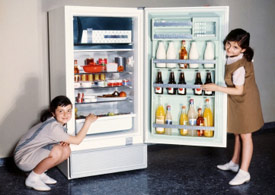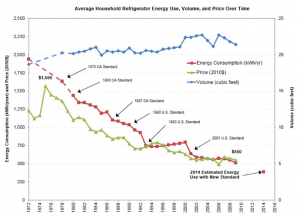A great story about on perhaps the most indispensable item in our homes from the American Council for an Energy Efficient Economy (ACEEE).
One of the great inventions of our time – the modern refrigerator – will get an efficiency makeover when new national efficiency standards go into effect on September 15, reducing energy use of most refrigerators and freezers by about 20-25%. The new standards take effect 100 years after the first modern refrigerators were mass-produced for general use. Before that time, consumers used iceboxes (literally boxes with ice) to keep their food cold, but food safety was an issue. When the ‘electric refrigerator’ was finally introduced it was more than just a convenience, it was an invention that saved people’s lives. (See this 1926 advertisement from the Electric League of Pittsburgh). Refrigerators have evolved considerably since the 1900s both in appearance and function. The early units placed the cooling device on top of a small boxy unit while today’s sleeker multi-door units place the cooling units unseen on the bottom.
The new efficiency measures are the latest in a series of standards over 40 years that have helped to significantly bring down the cost of running a typical refrigerator. A fridge that just meets the new standards will use $215 to $270 less per year in electricity than a comparable unit that met the first state standards set in 1978.
The refrigerator story is filled with intriguing plot lines – from the initial energy crisis in the ‘70s, to negotiations between disparate groups of stakeholders, to national legislation signed by President Reagan in 1987. It’s a good story packed with positive outcomes. The graph below gives a birds-eye view of some of the changes over the last 40 years. While energy use decreased more than three-fourths, refrigerator volume increased, and price (in $2010) decreased by two-thirds.
Read the rest of this article on the ACEEE blog.



